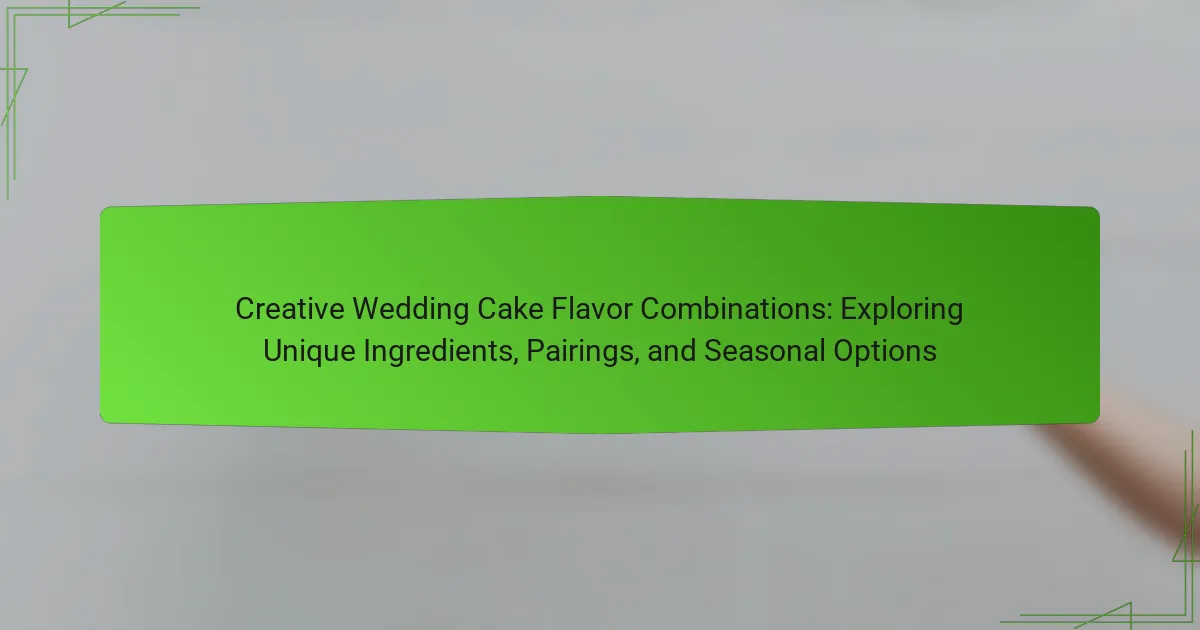
What are Creative Wedding Cake Flavor Combinations?
Creative wedding cake flavor combinations include unexpected pairings that enhance taste and presentation. Popular choices are lemon and lavender, which offer a refreshing floral note. Chocolate and raspberry create a rich yet tangy experience. Vanilla and almond provide a classic yet unique flavor profile. Another combination is carrot and cream cheese, which adds a spiced sweetness. Coconut and lime deliver a tropical twist. Red velvet and cream cheese frosting remains a favorite for its vibrant color and flavor. These combinations cater to diverse palates and can be customized for seasonal themes.
How do flavor combinations enhance the wedding cake experience?
Flavor combinations enhance the wedding cake experience by creating a more memorable and enjoyable taste profile. Diverse flavors can appeal to different palates, ensuring that every guest finds something they love. For instance, pairing chocolate with raspberry provides a rich yet tart contrast that excites the taste buds. Unique combinations, such as lemon and lavender, offer a refreshing and aromatic experience. Seasonal flavors, like pumpkin spice in autumn, can evoke a sense of nostalgia and celebration. Research shows that variety in flavors can increase satisfaction during food experiences. A study published in the Journal of Culinary Science & Technology highlights how flavor complexity enhances overall enjoyment. This evidence supports the idea that thoughtful flavor combinations elevate the wedding cake experience.
What are the key elements of a successful flavor combination?
Successful flavor combinations rely on balance, contrast, and harmony. Balance involves pairing flavors that complement each other without overpowering. Contrast highlights differences, such as sweet and savory, to create interest. Harmony ensures that flavors work together seamlessly, enhancing the overall experience.
For example, chocolate and raspberry create balance through sweetness and tartness. Vanilla and almond provide harmony with their subtle notes. Citrus and herbs, like lemon and rosemary, offer contrast while still complementing each other.
Research indicates that successful flavor pairings often include a mix of familiar and unexpected elements. This approach enhances the tasting experience and encourages creativity in flavor selection.
How do personal preferences influence flavor choices?
Personal preferences significantly influence flavor choices in wedding cakes. Individual tastes shape the selection of flavors based on past experiences and cultural backgrounds. For example, a person who grew up enjoying chocolate desserts may favor chocolate-flavored cakes. Additionally, dietary restrictions, such as allergies or veganism, also affect flavor selection. Seasonal ingredients play a role; people often prefer flavors that reflect the season of their wedding. Research shows that emotional connections to certain flavors can enhance enjoyment, making personal preferences vital in flavor decisions. Ultimately, the unique blend of individual taste, cultural influences, and emotional ties determines the final flavor choices for wedding cakes.
Why are unique ingredients important in wedding cake flavors?
Unique ingredients are important in wedding cake flavors because they enhance taste and create memorable experiences. Incorporating unique ingredients allows for personalization, reflecting the couple’s preferences. This customization can make the cake a standout feature of the celebration. Unique flavors can also evoke emotions and memories, adding depth to the event. For example, using locally sourced ingredients can connect the cake to the couple’s hometown. Additionally, unique ingredients can set a cake apart in a market saturated with traditional flavors. This differentiation can attract attention and generate interest among guests. Ultimately, unique ingredients contribute to the overall enjoyment and significance of the wedding cake.
What are some examples of unique ingredients for wedding cakes?
Unique ingredients for wedding cakes can include lavender, matcha, and Earl Grey tea. Lavender adds a floral note and pairs well with lemon. Matcha provides a vibrant green color and earthy flavor. Earl Grey tea infuses a hint of bergamot, enhancing the cake’s aroma. Other unique ingredients are almond extract, olive oil, and coconut milk. Almond extract gives a rich, nutty flavor. Olive oil creates a moist texture and subtle taste. Coconut milk contributes creaminess and tropical flair. These ingredients create distinctive flavor profiles, making wedding cakes memorable.
How do unique ingredients affect taste and presentation?
Unique ingredients significantly enhance both taste and presentation in culinary creations. These ingredients introduce distinct flavors that can elevate a dish beyond traditional combinations. For example, using lavender in a cake can add floral notes that create a unique sensory experience. Additionally, unique ingredients can influence the visual appeal of a dish. Ingredients like edible flowers or vibrant fruits can provide striking colors and textures. This visual enhancement is crucial in settings like weddings, where presentation is key. Studies show that first impressions of food are often based on appearance, impacting perceived taste. Therefore, unique ingredients play a vital role in both the flavor profile and the aesthetic value of wedding cakes.

What are popular flavor pairings for wedding cakes?
Popular flavor pairings for wedding cakes include classic combinations like vanilla and raspberry, chocolate and salted caramel, and lemon and blueberry. These pairings enhance the overall taste experience. Vanilla pairs well with fruity flavors, creating a light and refreshing profile. Chocolate complements richer flavors like salted caramel, providing depth. Lemon adds brightness when combined with blueberries, offering a tart contrast. Other popular combinations include almond and cherry, and red velvet with cream cheese frosting. These choices reflect trends in wedding cake flavor preferences.
Which flavor pairings are trending in wedding cakes right now?
Trending flavor pairings in wedding cakes include lavender and lemon, chocolate and raspberry, and vanilla and almond. Lavender and lemon provide a refreshing floral-citrus combination. Chocolate and raspberry create a rich and fruity contrast. Vanilla and almond offer a classic yet nutty flavor profile. These pairings have gained popularity due to their unique taste and aesthetic appeal. Recent surveys show couples favoring these combinations for their special day. Additionally, seasonal ingredients like pumpkin spice and apple cinnamon are also trending.
How do cultural influences shape flavor pairings?
Cultural influences shape flavor pairings by dictating the ingredients and combinations that are traditionally favored. Different cultures have unique culinary histories that inform their flavor preferences. For instance, Asian cuisines often emphasize umami and balance, leading to savory-sweet pairings. Mediterranean cultures frequently combine herbs and citrus, creating fresh and vibrant flavor profiles.
The use of spices varies significantly across cultures, impacting how flavors are paired. Indian cuisine, rich in spices, often combines sweet and spicy elements, influencing dessert flavor pairings. Historical trade routes have also introduced new ingredients to various regions, altering traditional pairings.
For example, the introduction of chocolate to European desserts has created a fusion of flavors that blends local ingredients with imported ones. Additionally, cultural celebrations and rituals often dictate specific flavor pairings, such as the use of fruit in wedding cakes across many cultures.
These factors collectively illustrate how cultural influences create a diverse landscape of flavor pairings in culinary practices.
What classic flavor pairings remain timeless for weddings?
Classic flavor pairings that remain timeless for weddings include vanilla and almond, lemon and raspberry, and chocolate and hazelnut. Vanilla and almond create a rich, aromatic base that complements various fillings. Lemon and raspberry offer a refreshing contrast, perfect for spring and summer weddings. Chocolate and hazelnut provide a decadent combination that appeals to chocolate lovers. These pairings are favored for their balance and versatility. They have been popular in wedding cakes for decades, making them reliable choices for couples.
How can flavor pairings complement wedding themes?
Flavor pairings can enhance wedding themes by aligning tastes with the overall aesthetic and mood of the event. For instance, a rustic wedding theme can be complemented by flavors like spiced apple and cinnamon. These flavors evoke warmth and comfort, resonating with a cozy atmosphere. In contrast, a beach wedding might benefit from tropical flavors like coconut and pineapple. These flavors create a refreshing and vibrant experience, matching the seaside setting. Additionally, seasonal ingredients can reflect the time of year, such as pumpkin in fall or berry flavors in summer. This alignment between flavor and theme creates a cohesive experience for guests. Studies show that sensory experiences, like taste, can significantly impact overall event enjoyment. Therefore, thoughtful flavor pairings contribute to a memorable wedding celebration.
What are some examples of flavor pairings for rustic weddings?
Rustic weddings often feature flavor pairings that evoke a natural, homemade feel. Common examples include vanilla bean paired with lavender for a floral note. Another popular combination is chocolate and salted caramel, providing a rich, sweet contrast. Lemon and rosemary create a refreshing yet earthy flavor profile. Additionally, spice cake paired with cream cheese frosting offers warmth and comfort. Lastly, almond and raspberry provide a sweet and nutty balance, enhancing the rustic theme. These pairings reflect seasonal ingredients and traditional flavors, making them ideal for rustic wedding cakes.
How do sophisticated flavors align with elegant wedding themes?
Sophisticated flavors enhance elegant wedding themes by providing a refined culinary experience. These flavors often include gourmet ingredients such as lavender, pistachio, and dark chocolate. They elevate the overall aesthetic and taste of the wedding cake. Elegant weddings typically emphasize luxury and detail. A cake featuring sophisticated flavors aligns with this vision through its complexity and artistry. For example, a cake infused with Earl Grey tea reflects both sophistication and modern trends. Additionally, unique flavor pairings can create memorable experiences for guests. This combination of taste and presentation reinforces the elegance of the wedding theme.

What seasonal options should be considered for wedding cakes?
Seasonal options for wedding cakes include flavors and ingredients that reflect the time of year. In spring, consider lemon, lavender, or strawberry for fresh, light tastes. Summer options can feature peach, raspberry, or coconut for a tropical feel. Autumn brings flavors like pumpkin spice, apple, or caramel for warmth and richness. Winter cakes can incorporate gingerbread, peppermint, or dark chocolate for a festive touch. These seasonal flavors enhance the cake’s appeal and align with seasonal celebrations.
How do seasonal ingredients impact flavor choices?
Seasonal ingredients significantly influence flavor choices in culinary creations. They provide freshness and enhance taste profiles. For example, berries in summer offer sweetness and acidity. In contrast, root vegetables in winter impart earthiness and warmth. Seasonal ingredients align with consumer preferences for sustainability and local sourcing. Studies show that using seasonal produce can enhance overall flavor perception. Additionally, seasonal ingredients often reflect cultural traditions associated with specific times of the year. This connection can evoke nostalgia and enhance the dining experience. Therefore, incorporating seasonal ingredients can create unique and memorable flavor combinations for wedding cakes.
What are the best seasonal flavors for spring weddings?
The best seasonal flavors for spring weddings include lemon, lavender, and strawberry. Lemon provides a fresh and zesty taste that symbolizes new beginnings. Lavender adds a floral note, enhancing the cake’s aroma and visual appeal. Strawberry offers a sweet and fruity flavor, perfect for spring celebrations. These flavors align well with the seasonal themes of renewal and growth. Additionally, they can be paired with complementary ingredients like vanilla or cream for a balanced taste. Using these flavors can create a delightful experience for guests.
How can autumn flavors enhance a fall wedding cake?
Autumn flavors can enhance a fall wedding cake by adding seasonal richness and warmth. Flavors like pumpkin, cinnamon, and apple evoke the essence of fall. These ingredients create a cozy atmosphere that resonates with the season. For example, pumpkin spice cake is a popular choice for autumn weddings. It combines the sweetness of pumpkin with warm spices. Additionally, apple cider cake can offer a refreshing yet comforting flavor profile. Incorporating these flavors can make the cake more memorable and thematic. Seasonal ingredients also allow for creative pairings with frostings and fillings. Overall, autumn flavors can elevate the cake’s taste and aesthetic, aligning it with the fall theme.
What are the benefits of choosing seasonal flavors for wedding cakes?
Choosing seasonal flavors for wedding cakes enhances freshness and taste. Seasonal ingredients are often harvested at their peak ripeness. This maximizes flavor and quality in the cake. Additionally, seasonal flavors can evoke specific emotions tied to particular times of the year. For example, pumpkin and spice flavors are popular in autumn. Seasonal options also support local farmers and reduce transportation costs. This choice can lead to more sustainable practices in cake production. Furthermore, seasonal flavors can create a unique and memorable experience for guests. Overall, using seasonal flavors in wedding cakes aligns taste with the time of year, ensuring a delightful celebration.
How do seasonal flavors contribute to freshness and taste?
Seasonal flavors enhance freshness and taste by utilizing ingredients at their peak ripeness. When fruits and herbs are in season, they contain optimal flavor profiles and nutrients. For example, strawberries in summer are sweeter and juicier than those available in winter. Seasonal ingredients also tend to be locally sourced, resulting in shorter transportation times. This reduces spoilage and preserves flavor integrity. Additionally, seasonal flavors resonate with consumers’ preferences for authenticity and connection to nature. Studies show that fresh ingredients can improve overall taste satisfaction in culinary applications. Thus, incorporating seasonal flavors into wedding cakes can elevate their appeal and quality.
What are the cost implications of using seasonal ingredients?
Using seasonal ingredients can significantly reduce costs. Seasonal produce is often more abundant and therefore less expensive. Prices typically drop when items are in peak supply. Additionally, local sourcing of seasonal ingredients can minimize transportation costs. This can lead to fresher products and lower overall expenses. For instance, strawberries in summer are cheaper than in winter. Moreover, utilizing seasonal flavors can enhance the appeal of wedding cakes, potentially attracting more customers. Overall, the cost implications favor the use of seasonal ingredients for budget-conscious wedding cake designs.
What tips can help in selecting creative wedding cake flavors?
Consider personal preferences and tastes when selecting wedding cake flavors. Start by discussing favorite flavors with your partner. Explore seasonal ingredients for fresh and vibrant options. Experiment with unique combinations, such as chocolate and lavender or lemon and rosemary. Incorporate cultural influences that reflect your heritage. Conduct taste tests with a variety of flavors to ensure satisfaction. Consult with a professional baker for expert recommendations. Research trending flavors for inspiration, such as matcha or chai spice.
How can couples incorporate their personalities into flavor choices?
Couples can incorporate their personalities into flavor choices by selecting flavors that reflect their individual tastes and experiences. They can choose flavors based on their favorite desserts or cuisines. For example, if one partner loves chocolate and the other prefers fruity flavors, they can create a cake that features both chocolate and fruit layers. Additionally, couples can consider unique ingredients that have personal significance, such as a flavor from a memorable trip or a family recipe. This approach allows them to create a cake that tells their story. Personalizing flavor choices also enhances the overall wedding experience, making it more meaningful.
What should be considered when tasting and selecting flavors?
When tasting and selecting flavors, consider balance, intensity, and personal preference. Balance ensures that no single flavor overpowers the others. Intensity refers to the strength of each flavor and how it complements the overall profile. Personal preference is crucial; individual tastes vary widely. Seasonal ingredients can enhance freshness and relevance. Texture also plays a role, as it affects the overall mouthfeel. Finally, consider the occasion; flavors should align with the event’s theme and mood.
Creative wedding cake flavor combinations encompass unique pairings that enhance both taste and presentation, featuring popular choices such as lemon and lavender, chocolate and raspberry, and vanilla and almond. The article explores how these combinations improve the wedding cake experience by appealing to diverse palates and creating memorable flavors. Key elements of successful flavor pairings include balance, contrast, and harmony, while personal preferences and cultural influences play significant roles in flavor selection. Additionally, the article highlights the importance of seasonal ingredients and unique components in crafting distinctive wedding cakes that align with specific themes and evoke emotional connections.
